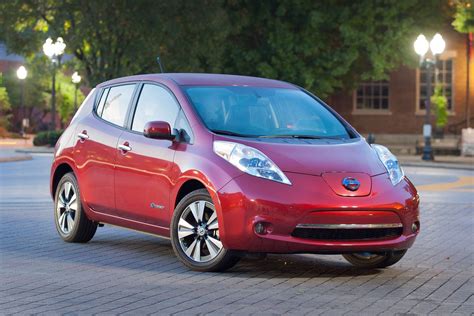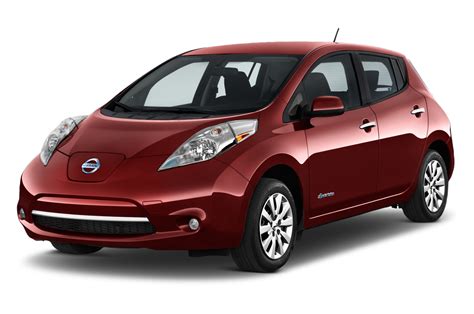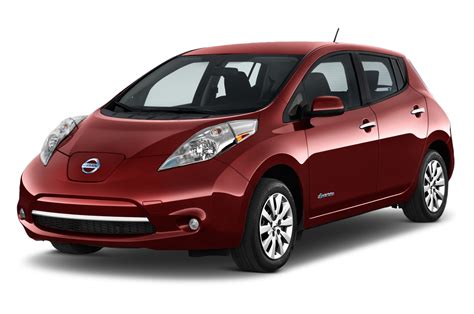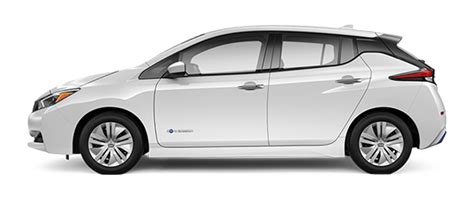2017 Nissan Leaf problems

The Nissan Leaf (Japanese: 日産・リーフ, Hepburn: Nissan Rīfu), stylized as "LEAF," is a battery-electric powered compact car manufactured by Nissan, produced since 2010 across two generations. It has been offered exclusively as a 5-door hatchback. The term "LEAF" serves as a backronym to leading environmentally-friendly affordable family car.
The Leaf was unveiled on 1 August 2009 as the world's first mass market electric and zero-emission vehicle. Among other awards and recognition, it received the 2010 Green Car Vision Award, the 2011 European Car of the Year, the 2011 World Car of the Year, and the 2011–2012 Car of the Year Japan. A second-generation Leaf was introduced in October 2017. The Leaf's range on a full charge has been steadily increased from 117 km (73 miles) to 364 km (226 miles) (EPA rated) by the use of larger battery packs and several minor improvements.
Global sales across both generations totalled 577,000 by February 2022. As of September 2021, European sales totalled more than 208,000, and as of December 2021, over 165,000 had been sold in the U.S., and 157,000 in Japan. The Leaf was the world's all-time top selling plug-in electric car until it was surpassed in early 2020 by the Tesla Model 3.

Social links
Common 2017 Nissan Leaf problems
The Nissan Leaf, particularly the 2017 model, has been reported to have several common problems based on complaints from owners. One of the most significant issues is related to the battery, with numerous owners reporting problems such as rapid battery depletion, reduced battery capacity, and battery failure. These issues can lead to a significant reduction in the vehicle's range and, in some cases, require expensive battery replacements.
Another common problem with the 2017 Nissan Leaf is related to the in-car electronics. Some owners have reported issues with the infotainment system, including problems with the touchscreen and the navigation system. These issues can affect the overall usability and convenience of the vehicle.
The climate system has also been reported as a problem area for the 2017 Nissan Leaf. Some owners have reported issues with the air conditioning and heating systems, including problems with the fan and temperature control. These issues can affect the comfort of the vehicle, particularly in extreme temperatures.
The EV charging system has also been reported as a problem area for the 2017 Nissan Leaf. Some owners have reported issues with the charging cord, including failures and malfunctions. These issues can affect the vehicle's ability to charge, which can be a significant inconvenience for owners.
The steering and suspension system has also been reported as a problem area for the 2017 Nissan Leaf. Some owners have reported issues with the steering, including problems with the power steering system. These issues can affect the handling and safety of the vehicle.
The brakes have also been reported as a problem area for the 2017 Nissan Leaf. Some owners have reported issues with the brakes, including problems with the brake pads and rotors. These issues can affect the safety and performance of the vehicle.
Finally, the drive system has been reported as a problem area for the 2017 Nissan Leaf. Some owners have reported issues with the electric motor and transmission, including problems with the power and acceleration. These issues can affect the performance and efficiency of the vehicle.
In summary, the 2017 Nissan Leaf has been reported to have several common problems, including issues with the battery, in-car electronics, climate system, EV charging system, steering and suspension, brakes, and drive system. These issues can affect the safety, performance, and convenience of the vehicle, and some can be quite expensive to repair.

What is the most common problem of Nissan Leaf?
Most Common Nissan LEAF Problems
- Nissan LEAF Battery Degradation.
- Problems with the Automatic Emergency Braking (AEB) System.
- Power Inverter Failure.
- Diminished Range During Low Temperatures.
How long will the 2017 Nissan LEAF last?
around ten years
Generally, you should expect the Nissan Leaf to last for around ten years. Because electric car batteries last so long, many outlast other components of the car, so you might get a new car before your battery's condition becomes an issue.
What is the disadvantage of Nissan Leaf?
Lows Lacks range, DC fast-charging limited to 50 kW, cheaper competitors offer more range. Verdict The Nissan Leaf is an easy way to get into an electric vehicle, but its lack of range and slow charging make it tough to live with.
Does the Nissan Leaf have battery problems?
More Leaf owners with battery problems say Nissan has abandoned them. As more Nissan EV owners come forward to say they feel abandoned by the automaker and its failure to supply replacement batteries for the Leaf, one lawyer with a firm specializing in class actions says there might be a case.
2017 Nissan Leaf complaints
The NHTSA has received 0 complaints about various vehicle components related to the 2017 Nissan Leaf.
You can leave your car complaint via the special form below.
2017 Nissan Leaf recalls
The National Highway Traffic Safety Administration (NHTSA) has issued 2 recalls for different components of the 2017 Nissan Leaf.
- Manufacturer: Nissan North America, Inc.
- Components: EQUIPMENT:OTHER:OWNERS/SERVICE/OTHER MANUAL
- Summary: Nissan North America, Inc. (Nissan) is recalling certain 2013-2017 LEAF vehicles. The Owner's Manual instructions for defroster operation are incorrect and may result in reduced defroster performance under specific conditions. As such, these vehicles fail to comply with the requirements of Federal Motor Vehicle Safety Standard number 103, "Windshield Defrosting and Defogging Systems."
- Consequence: Reduced defroster performance can limit visibility out of the windshield, increasing the risk of a crash.
- Remedy: Nissan will mail an addendum with updated instructions on how to operate the defroster, free of charge. Owner notification letters are expected to be mailed May 26, 2023. Owners may contact Nissan's customer service at 1-800-867-7669. Nissan's number for this recall is R23A1.
- Manufacturer: Nissan North America, Inc.
- Components: AIR BAGS
- Summary: Nissan North America, Inc. (Nissan) is recalling certain 2015-2017 LEAF and 2014, 2016 and 2017 Sentra vehicles. Due to a manufacturing error within the air bag inflators, the passenger frontal air bag may not properly deploy in the event of a crash.
- Consequence: In the event of a crash, if the front passenger air bag doesn't deploy properly, it can increase the risk of injury to passengers.
- Remedy: Nissan will notify owners, and dealers will replace the front passenger air bag inflator, free of charge. The recall began June 7, 2017. Owners may contact Nissan customer service at 1-800-647-7261.
Negative 2017 Nissan Leaf car reviews
Positive 2017 Nissan Leaf car reviews
-

We purchased this car in December of 2015. It has been 6 years and 7 months since then, and we have driven 59K miles. I am happy to report that it runs just as well as the day I bought it! In fact, it has never broken down. The only maintenance I have done is replace the 12-volt battery at the 5-year mark, as that tends to be its limit. I also put on a set of winter tires. So far, there has been no battery degradation (there's a bar indicator on the range gauge). Nissan provides a once-a-year free battery check to maintain the battery warranty, which is good for 8 years. Since we installed solar panels on our roof in April 2021, 100% of our electricity has come from the sun, which of course includes charging the LEAF. Some people who don't know much about electric cars or the LEAF think it's slow, but I can assure you that it can easily keep up with traffic and accelerate quickly into traffic from on-ramps. The only downside of this 2015 LEAF is its limited range, but for me, it doesn't matter because it's a second car used for errands and I don't need to travel more than 50 miles from home. The new LEAFS and most EVs now have ranges between 200-300 miles and can recharge to 80% from nearly empty in about 15 minutes. Overall, I am sold on EVs. The low cost from virtually zero maintenance, excellent reliability, free kilowatts from the sun to power it, and excellent performance are a winning combination!
-

This car is fantastic! Having a filling station at home in my garage has been a game changer. Not only do I save money on fuel and maintenance, but the quiet ride is a real treat, especially when driving through the neighborhood with the windows down on a beautiful day. Admittedly, my first reaction to the styling wasn't great, but it's grown on me and now I absolutely love it. The only downside is that my wife keeps taking it, leaving me stuck filling up her Prius with gas. By the way, there are some amazing deals on these cars available right now!
-

I recently sold my Nissan Leaf due to concerns about its resale value. During my second winter of ownership, I noticed a significant decrease in battery life, with my range dropping below 90 miles per charge. I was worried that this trend would continue, causing my car's value to plummet. Additionally, owning an electric car requires a second vehicle to fully benefit from its features, which was becoming increasingly stressful for me as my VW van was also experiencing issues. Despite these challenges, I have no regrets about purchasing the Leaf. Thanks to the rebate, I paid no federal income tax in 2017, and I enjoyed the experience of owning an electric car. While I am not actively seeking to purchase another electric car, I would consider it if the right deal presented itself.
-

If you only need a second car for short commutes, this option is unbeatable. However, if you plan on using it for more than that, you may encounter some challenges. Owning an EV is like taking up a new hobby that revolves around learning everything there is to know about lithium-ion batteries. I may soon get over this phase and settle into a normal routine, but that's how it feels at the moment.
-

We are thrilled with our 2017 Leaf SL! It has exceeded our expectations in so many ways, from its peppy performance to its impressively low operating costs. The ride is quiet and dignified, making for a truly enjoyable driving experience. We were pleasantly surprised to find that the vehicle's range is actually greater than advertised, at around 120 miles. Thanks to federal and state tax incentives, a generous discount from our local utility, and a great deal from our dealer, we were able to purchase the Leaf for just 60% of the sticker price. Even with our trade-in of a 2010 CRV, our out-of-pocket expense was less than $10K. The Bose sound system is top-notch, the seating is incredibly comfortable, and the handling is solid. But what really sets the Leaf apart is its energy savings - in just one month, we drove 581 miles and only paid $14.00 in electricity, even with a few free
Additional sources
More sources of information about 2017 Nissan Leaf problems:

Potential leaf owner here. Any major concerns to be aware of? : r ...
Jul 19, 2021 ... The biggest problem is that the LEAF is the only EV that does not have a liquid cooling system for the battery. This means that if you use ...
2017 Nissan Leaf Reliability - Consumer Reports
What Owners Say · Electric/hybrid battery pack replacement. "Car charge depletes quickly and battery capacity has been reduced. · "turtle with an exclamation ...
2017 Nissan LEAF Problems | Kelley Blue Book
How reliable is the 2017 Nissan LEAF? See the most common repairs performed and learn if your vehicle is at risk for major repairs in the next 12 months.
Sudden Motor Power Loss resulting in car stalled on the side of the ...
Dec 8, 2022 ... My Nissan Leaf ... Nissan Leaf Facebook Group · LEAF Ownership · Problems / Troubleshooting ... Nissan Leaf 2017 30 kWh Battery Pack. Thread ...
Here Are The Nissan Leaf Years To Avoid - CoPilot
Jul 21, 2023 ... Another common problem with the Nissan Leaf is that the passenger sensors start to fail. That can be a serious safety concern since the ...
Other years of Nissan Leaf
Are you having problems with your 2017 Nissan Leaf?









Mohamed Gerhold 2025-06-11
I wanted to share my experience with my Nissan Leaf. After owning it for two years, I noticed that the battery started degrading rapidly, which was disappointing. On a full charge, the mileage range was approximately 85 miles, but now, after two years, it's approximately 70 miles on a good day. Unfortunately, I can't use my radio, heater, or a/c because the mileage range will drop to 55 on a full charge. However, I do appreciate that I have the 220 outlet for the charger at home, which gets a full charge within about 3 hours. If you use the 110, it will take up to 12 hours or more for a full charge. Although I'm disappointed with the battery life, I still like the car. I'm considering selling it, but I've learned that it's worth less than what I still owe on it.
Luigi Herman 2025-04-10
I purchased a 2016 Leaf with an extended range of 108 miles after owning a 2013 Leaf for 2.5 years with no noticeable battery degradation. Unfortunately, my 2016 Leaf has lost 31% of its original battery capacity after 19 months and 7000 miles. A full charge now indicates 74 miles, however, during my last drive, I traveled 44 miles round trip and was left with only 12 miles of capacity when I returned home. Before purchasing this car, it's important to consider if it will meet your needs. Nissan has stated that battery degradation is normal and my car currently charges at 9 out of 12 bars on their charging scale. They won't replace the battery until it reaches 8 out of 12 bars. While I'm disappointed with the current range of my car, it's important to note that this may not be an issue for everyone. Would this car work for you? I can only drive 22 miles from my home if I want to make it back home. It's important to consider all factors before making a decision.
Dewitt Nicolas 2025-02-08
During winter days when the temperature is above 20 degrees, I am fortunate to get 50 miles on a single charge. However, I have noticed that the heating system is not very effective. Although the heated seats work fine, the feet and leg area remain cold and do not warm up, which can be uncomfortable during long commutes of 24 miles.
Dereck Shields 2024-05-09
Your battery pack will degrade over time, it's just a matter of time. Ours are failing and Nissan will do nothing to help. However, we want to help you avoid any potential issues, so please be aware of this. Consider yourself warned!
Lafayette Mueller 2024-04-29
The range promised did not match the range delivered. When driving at 65 mph, the range is only 45 miles before needing to search for a charging station. This may not meet the expectations of some drivers. It is important to consider your driving needs before making a purchase. While this car may not be suitable for long distance travel, it may be a good option for short commutes. It is important to do your research and consider all options before making a decision. We understand that this may have been a difficult experience for you, and we hope that you are able to find a vehicle that meets your needs in the future.